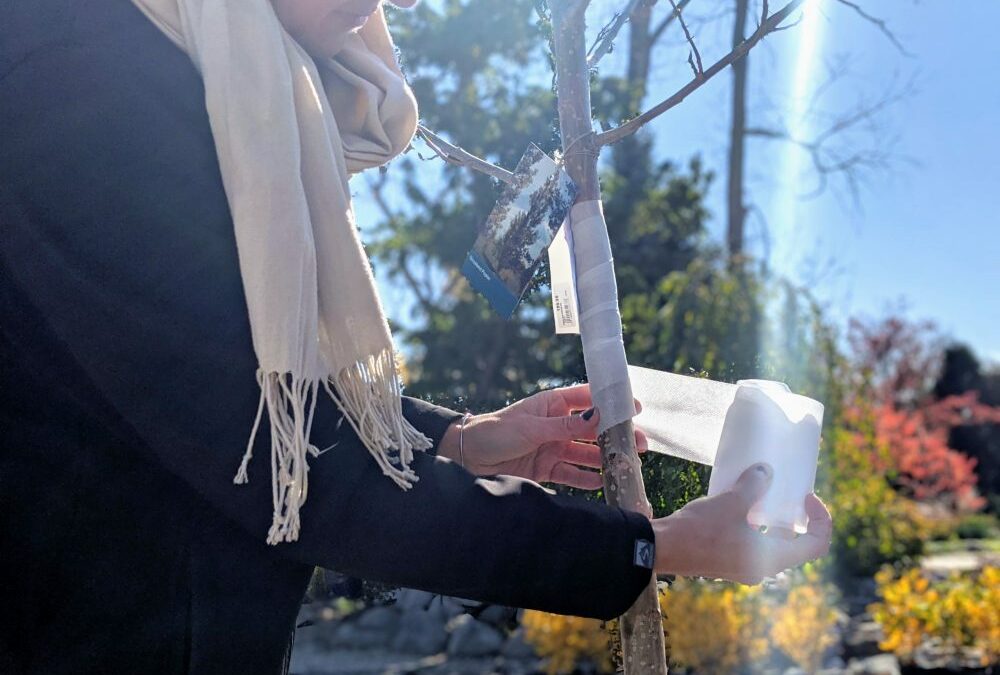Wrap New Trees
We recommend new trees, also known as saplings, are wrapped with a protective tree wrap or vinyl guards end of October to help protect against sun scald and frost crack. If you tree does experience winter damage it’s not necessarily terminal for the tree but can increase chances of disease and insect damage. The wrap can also help deter animal damage during winter.
Wrap up to the first tier of branches coming out of the truck and slightly overlap the wrap as you go up the tree.
Remove the wrap in spring after freezing temps have passed because you don’t want to trap moisture and heat when it warms up. There are wraps that state they can be used all year-round so read packages before keeping on all year. This should be continued every year until the bark begins to thicken and roughen.
Trees with higher susceptibility to winter damage:
Apple, Beech, Crabapple, Elm, Horse Chestnut, Linden, Oak, Walnut, and Willow.
Guard Evergreens Against Harsh Winter Weather – and Animal Damage
We love the addition of evergreens to almost any yard. The year-round texture, color and refuge for wildlife is something you can’t replicate with other trees. Plus they look great covered in fresh snow and holiday lights.
The same winter weather and snow that contrasts nicely with our beautiful green and picturesque evergreens can sometimes cause damage.
Protection Against Winter Air and Snow
1. Water Thoroughly
Keep evergreens well hydrated throughout the year. Proper watering depends on soil drainage, weather, and size of the plant. Average is around 5 gallons of water a week to two weeks for shrubs and trees. If the soil is still moist, wait to water. Water thoroughly one day and not every day. Continue to provide ample moisture until the ground freezes.
2. Cover Soil
Surround evergreens with a fresh layer of insulating mulch to regulate the soil temperature and seal in moisture. Once the ground freezes, the roots cannot replace lost water, and sun and wind can deplete it from the foliage, a double whammy for your evergreens.
3. Spray with Wilt Stop®
Evergreen leaves have more surface from which to lose water, so they are more susceptible to winter desiccation (drying). This can be prevented with an anti-desiccant spray like Wilt Stop that helps to seal in moisture and protect your broad and narrow-leafed evergreens.
Wilt Stop is it is natural and non-toxic— made from the resin of pine trees—and it forms a soft, clear and flexible barrier over foliage to prevent your evergreen from drying out.
4. Build a Burlap Barrier
If evergreens are planted on the South/Southwest side of your home, they may be getting the worst of the winter winds and scalding winter sun – a damaging combo. Watch the video above for best examples.
Post sturdy metal or wooden stakes at an angle around the evergreen trees, then wrap with burlap, making sure to keep the top open for light and air flow. The natural, porous fiber of the burlap or similar fabric allows some wind to pass through, making it resilient enough to withstand the wind, but minimizing the strongest, coldest gusts from reaching your evergreen. This can also minimize the accumulation of large amounts of drifting, damaging snow. When the snow starts to accumulate in the winter it helps keep rabbits from being up to sneak under and munch on your plant when they are wanting to start eating anything they can find. Use of animal repellents is also recommended if you have a large number of animals around your home.
5. Buddy-Tie Evergreen Branches
This is the same philosophy that is used when we buddy-tape a weaker, sprained or broken finger to a stronger one for support.
Some evergreens have multiple leaders or two dominant branches. On their own, they can be more susceptible to breakage from heavy snow and ice at the area where the trunk branches into two.
By joining the two leaders approximately halfway up from the weak crotch area, you give them stability and strength. You can use strips of strong cloth (the rest of your burlap) or nylon stockings for the bind.
Remove buddy-tie before spring growth to allow movement and prevent girdling.

